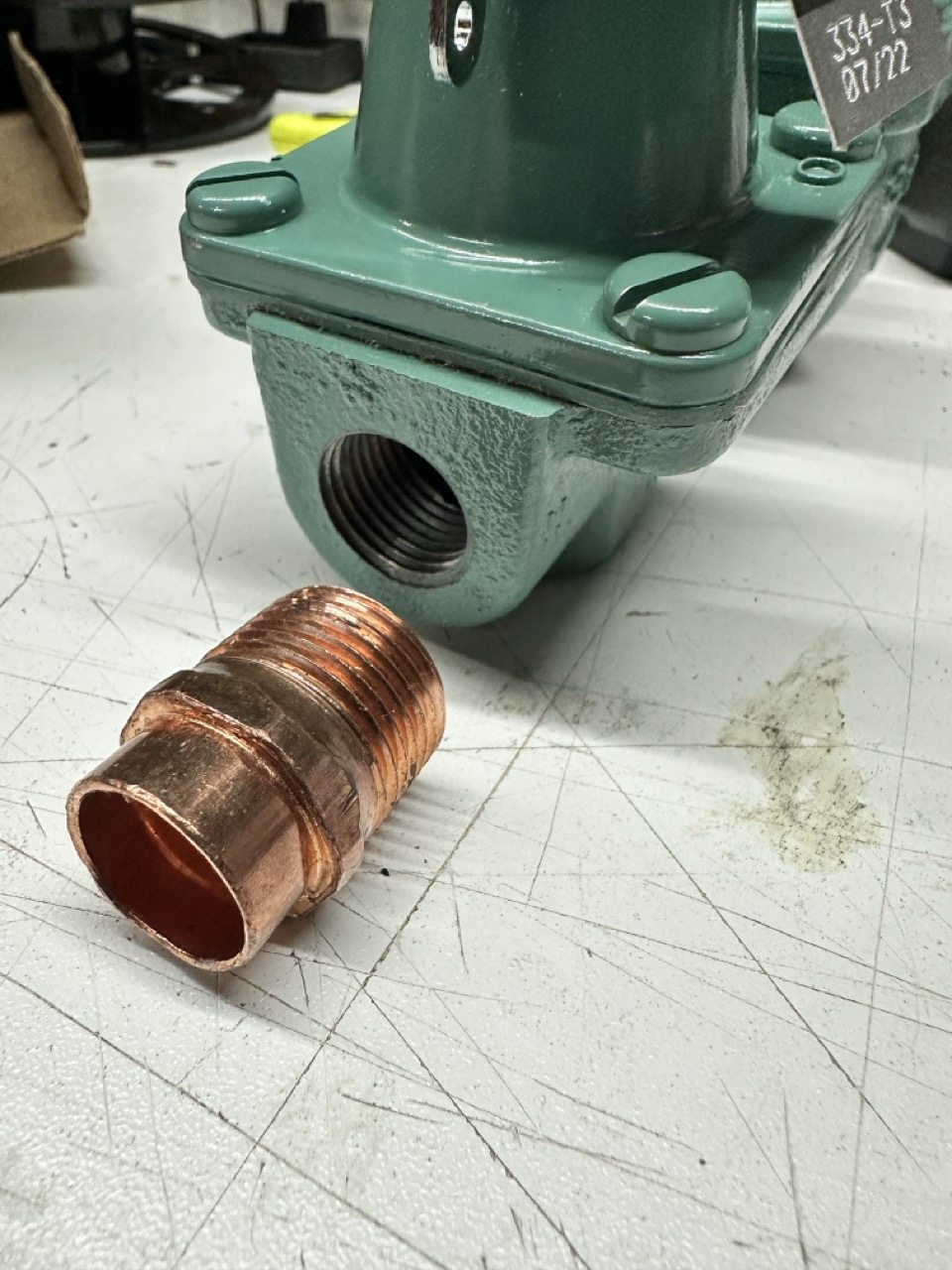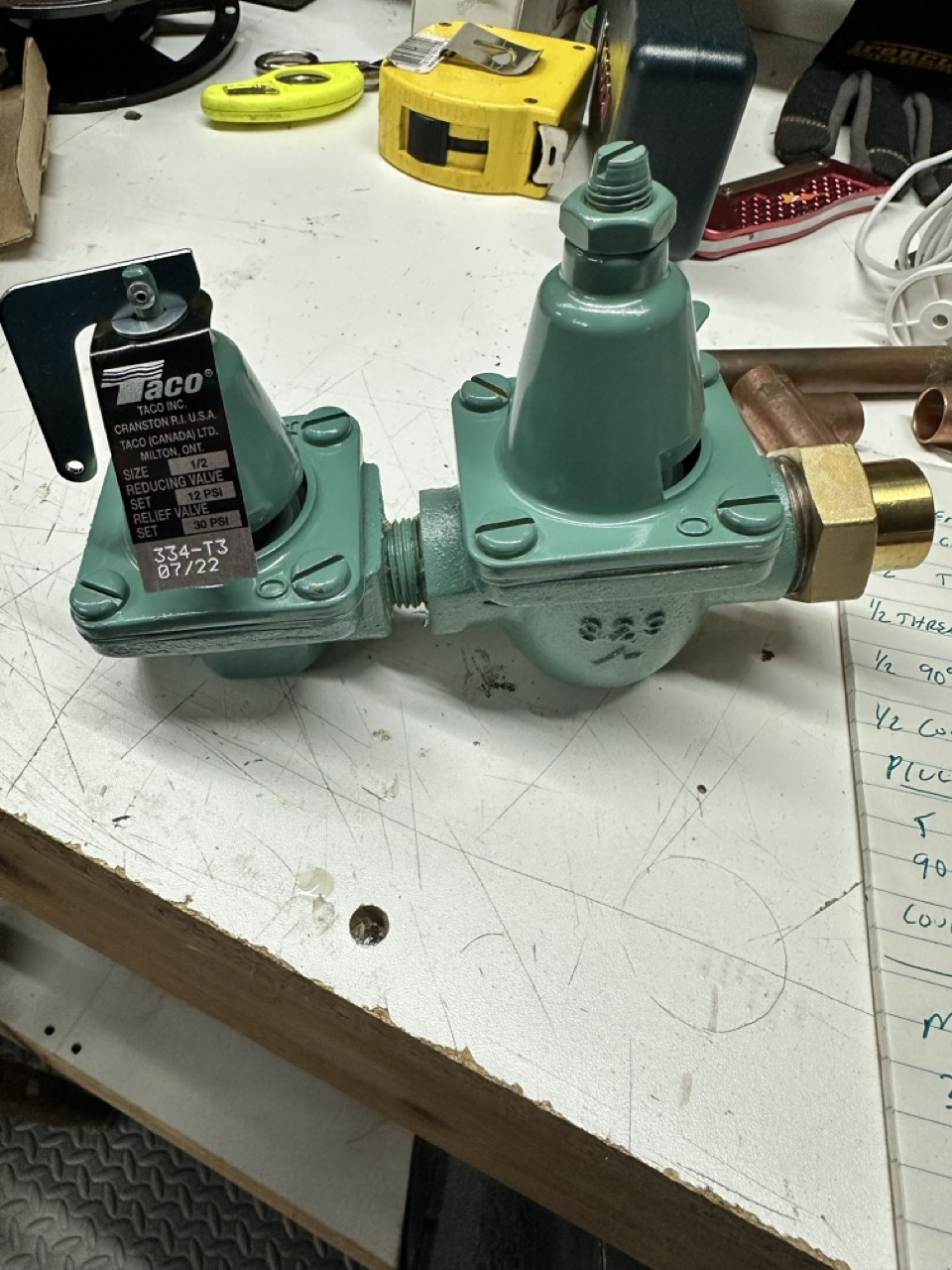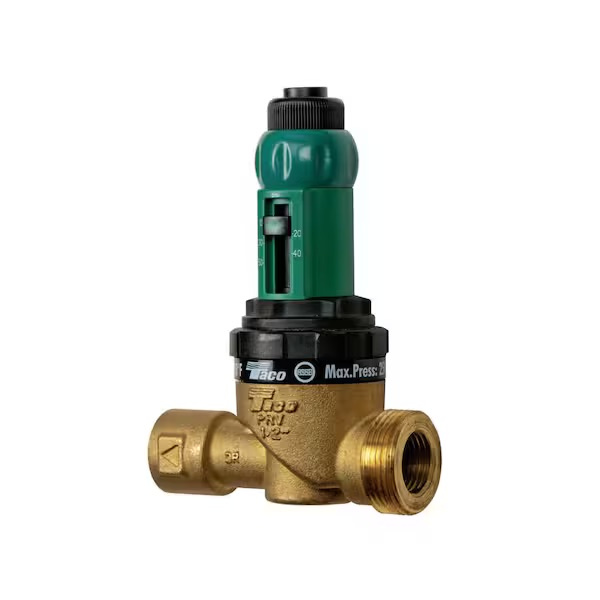Slow drip from taco pressure reducing valve
I've got a forced hot water system powered by a weil mclain lp hot water heater and the Taco pressure reducing valve has started dripping slowly. It's more pronounced now that the heat is actually getting used.
The boiler pressure kPa is reading just under 30 ( I am not sure if this is normal I'm suspecting it isn't as the valve is either failing or trying to keep up with pressure reduction and is dripping )
Another thought would be the expansion tank possibly failing causing more pressure?
What could be some steps I could take to either troubleshoot or is this a clear cut case of shut the water off before the Taco reducing valve and install a new one?
Pics below to illustrate further.



Comments
-
Your pressure gauge is actually reading about 30 PSI or about 200 KPa. This is too high. The gauge should read about 12PSI.0
-
Why are there TWO pressure reducers in-line. Older and newer?0
-
can we see another picture showing the entire boiler and all the pictured parts aboveknown to beat dead horses0
-
and I think the second "reducer" is actually a backflow device,
it says drain on its bottom open port,
that where you're seeing the drip? or from the safety valve?(not pictured)known to beat dead horses0 -
-
OK, That is a combination pressure relief valve, pressure reducing (auto feed) valve sold as a package. (this is today's version )
https://www.supplyhouse.com/Taco-334-T3-Taco-Dual-Unit-Valve-Threaded-1995000-p?gclid=Cj0KCQjwxNT8BRD9ARIsAJ8S5xaY9A2RJvL4X6tmvYP35BvryqS8CxVpJ4iPd-aNbUIfDi3Dk5q4FaEaAh51EALw_wcB
The relief valve portion is designed to release pressure at 30 PSI. So it appears that the relief valve is don't its job. that is letting excess pressure at 30#. The longer you have the relief valve opening to release water pressure, the more likely it will fail permanently and not close when the pressure is reduced below the 30# setting.
When water is heated, it expands. When water cools off. it contracts. Consider you have a full system with no air in the radiators and no air in the boiler... Where does the expanded water go when the burner comes on and heats the water. Remember it is a closed system with no openings anywhere. Think of it like a bottle with pipes attached... all filled with water and no other openings anywhere.
Water can't compress so Hydraulic pressure builds up as the water is heated and BOOM... or if you have a relief valve...Then... Swoosh or drip, drip, drip.
If you have a tank filled with air, (Air can compress) then the expanded water can go into that tank and compress the air. When the water cools off and gets smaller, the compressed air can push the water from the tank back into the boiler and radiators because it is now less water.
My guess is the Extrol No. 30 tank has no air left in it. That tank is designed to have 12 PSI air pressure in it from the factory. The air is separated from the waterside by a membrane called a bladder. If the blader is not compromised you can add air to the tank. If the bladder is compromised then the tank needs to be replaced. By the look of it, the tank is pretty old and the bladder is most likely compromised.Edward Young Retired
After you make that expensive repair and you still have the same problem, What will you check next?
0 -
They are not the same item, look closely, and see one has a drain hole in the bottom, the other does not. the drain hole is leaking because the boiler is at 30 PSI. the relief valve is supposed to let water out at 30 PSI. My guess is... that part is working properly.psb75 said:Why are there TWO pressure reducers in-line. Older and newer?
There should be a safety tube attached to the relief valve that extends to a drain or at least to within 6" of the floorEdward Young Retired
After you make that expensive repair and you still have the same problem, What will you check next?
0 -
what I was getting at with the request for boiler picture is -
is there a domestic system attached to the boiler also ?known to beat dead horses0 -
There may be another pressure relief valve on the boiler also.
What is the cold pressure of the boiler?0 -
To EdTheHeaterMan: So...what IS that other item in the picture with the identical green "bell" cover with a pressure reducing stem on top? It seems to have a threaded hole on the bottom too, with a hex plug in it. Odd that.0
-
the one on the left is the "primary" reducer,
there's (was) a screen inside that bottom,known to beat dead horses0 -
I don't understand a "primary" reducer. So the other is a "secondary "reducer? I need to know if this is an hydronics principle with which I am not familiar.0
-
@psb75
look at this: https://s3.amazonaws.com/s3.supplyhouse.com/product_files/Pressure_Reducing_Valves329-329T-335-334-334TInstall2222.pdf
it is the most current version.
The one on the left is the pressure-reducing valve, the one on the right is a standard 30 PSI relief valve. Many boilers before 1930 did not come with relief valves. This was an easy way to include a relief valve with the installation.
When these feed valves are left in place during a modern boiler install. (1960 to present) the new boiler has 2 relief valves. The one that comes with the boiler and the one left behind by the installer of the new boilerEdward Young Retired
After you make that expensive repair and you still have the same problem, What will you check next?
0 -
I don't understand this either.psb75 said:I don't understand a "primary" reducer. So the other is a "secondary "reducer? I need to know if this is an hydronics principle with which I am not familiar.
I'd like a further explanation from @neilc
Does the fact that there is a primary mean that there is a secondary pressure reducer?
I think not, but correct me if I'm wrong.
Edward Young Retired
After you make that expensive repair and you still have the same problem, What will you check next?
0 -
-
let me try this again,
and look, I'm no expert, I just play one on the internet,
the one on the left is a pressure reducing regulator, it has the adjustment screw up its top, and a filter screen inside that bottom cap.
the one on the right, with the drain port on its bottom, is or ought be a backflow protection device,
and I don't see any fast fill lever on its top, for that matter, how would a fast fill operate AFTER the pressure reducer?
wouldn't it need to be one assembly, like a modern pressure reducer w/fast fill ?
looking back at the picture one more time, if that is a lever up there, I'm gonna call it a test lever to check the valve, the safety valve, and I'm no longer calling it a backflow.
I'll be over here.known to beat dead horses0 -
and now looking at Ed's link,
I'll stand downknown to beat dead horses0 -
The pressure reading on the gauge, whether static or dynamic, is based on the height of the system. I see nothing in the post referring to elevation.TomS said:Your pressure gauge is actually reading about 30 PSI or about 200 KPa. This is too high. The gauge should read about 12PSI.
@EdTheHeaterMan deserves a big thank you for his input in this thread that is otherwise full of a lot of highly confident guesswork.neilc said:I'm no expert, I just play one on the internet,
the one on the right, with the drain port on its bottom, is or ought be a backflow protection device,
Contact John "JohnNY" Cataneo, NYC Master Plumber, Lic 1784
Consulting & Troubleshooting
Heating in NYC or NJ.
Classes1 -
-
-
Certainly, here is another photo of the entire unit and another of the reducing valves.neilc said:can we see another picture showing the entire boiler and all the pictured parts above
This would be in the NH area, so elevation would be related to my geographical location which hopefully helps.
a 0
0 -
So I finally got around to swapping out the old expansion tank with a brand new one. Checked that it was charged at 12 psi, and replaced the tank. Upon installation I checked the tank again and it reads 16psi.
The gauge on the boiler still reads a tad below 30 and the pressure reducer valve still drips.
I am at a bit of a loss as to what the boiler pressure reading should actually be, since I don’t have any baseline for what is normal, perhaps 30 psi is normal?
I also asked my local municipality about any change in water pressure and was told it’s all gravity based and they couldn’t offer any assistance.
My only other thought is that there is air in the system still causing a rise in pressure, not sure what else to do other than order another pressure reducer valve and hope that sorts it but from reading Ed’s explanation, I don’t think that’s the case.
One other thought is that the main water line splits, one going through the pressure reducing valve to the boiler and another that bypasses the valve and goes to a hot water boiler with its own expansion tank.
That tank on the hot water boiler side reads at 51psi and it’s made by Watts. I did not install this so it’s unknown if it was set to 12 psi as well or not. It is a few years old and not leaking.
My thought is that perhaps that pressure is too much and backfeeding into the line causing the higher boiler pressure? Or perhaps the taco reducer needs to be reduced to 12psi and not 30?
0 -
Hopefully the domestic hot water heater (boiler?) has no connection to the heating boiler, other than the feed lines. It should have an expansion tank (and you mention one) and its pressure will be that of the domestic water supply. 51 pounds sounds about right.
Unless you have an exceptionally tall house, however, the pressure in the heating side when the system is cold should be between 12 and 15 psi -- no more than that. Ideally the pressure gauge on the heating boiler should show that pressure, but unhappily they have been known to lie. As a first pass, though, try closing the valve in the water supply from your domestic water and draining some water from the heating system -- not much, mind you -- and that gauge should show a drop in pressure. If it does, try draining a bit at a time so that it reads 12 to 15 pai. Now the fun part: reopen the valve from the water supply. The pressure should stay about the same. If it doesn't -- if it rises -- the pressure reducing valve is either shot or not correctly adjusted. If the installed pressure gauge doesn't cooperate, you can get a gauge from the big box and a few fittings and connect it to a handy drain and use that.
And kindly report back...Br. Jamie, osb
Building superintendent/caretaker, 7200 sq. ft. historic house museum with dependencies in New England0 -
I had just replaced the leaking gaskets on the circulator pump and the gauge did indeed go down to zero then back up again when everything was put back together.
I did try what you suggested above and it made no difference. I then adjusted the pressure reducing valve and that made no difference.
So, I put an order in for a replacement and some new shutoff valves and will swap this out and hopefully then, the leaking will cease and the boiler will read around 12psi.0 -
The municipality is still taking forever to come out to shut the water off claiming back logs of work and that this isn't an emergency that requires their immediate attention.
The drip was very slow at first but now it's constant so it's certainly time to swap this out. My only question I have now is the replacement I ordered that is a check valve/pressure reducing system by Taco 334-T3 is made of cast iron and I have copper piping so the possibility of corrosion of two dissimilar metals exists. Maybe I'm overthinking this but I wanted to double check first.
Would this be acceptable to use as a connector?This is the new replacement I have on hand:
This is some new style pressure reducer I saw but lacks a back flow check valve so I'm not sure if this would be a viable option or even better compared to what I have, only that it's a brass body. There are so many other variations I'm not sure what else to go with as what I originally picked up was a close visual match to what I had previously but it's a cast iron body which I did not notice until now.
0
Categories
- All Categories
- 87.3K THE MAIN WALL
- 3.2K A-C, Heat Pumps & Refrigeration
- 61 Biomass
- 429 Carbon Monoxide Awareness
- 120 Chimneys & Flues
- 2.1K Domestic Hot Water
- 5.8K Gas Heating
- 115 Geothermal
- 166 Indoor-Air Quality
- 3.7K Oil Heating
- 77 Pipe Deterioration
- 1K Plumbing
- 6.5K Radiant Heating
- 395 Solar
- 15.7K Strictly Steam
- 3.4K Thermostats and Controls
- 56 Water Quality
- 51 Industry Classes
- 50 Job Opportunities
- 18 Recall Announcements





